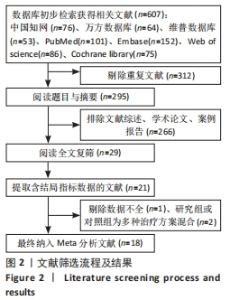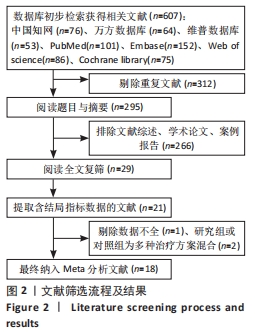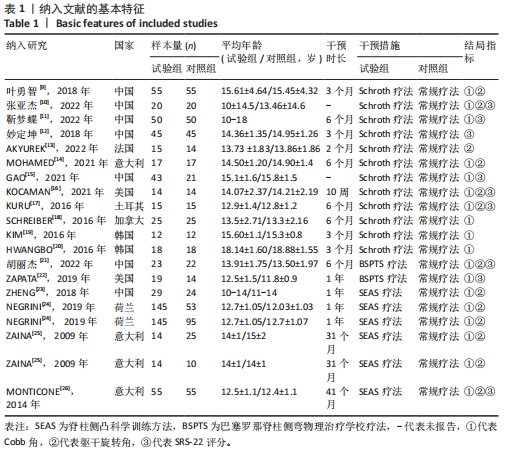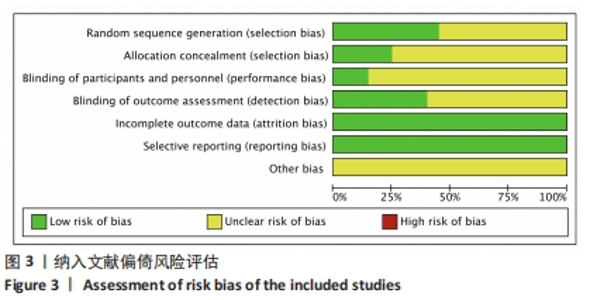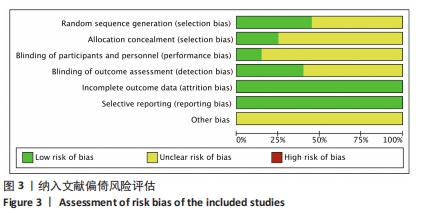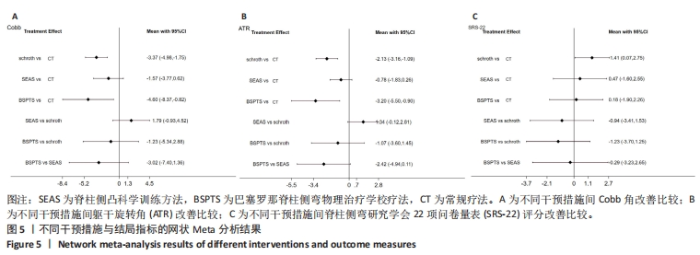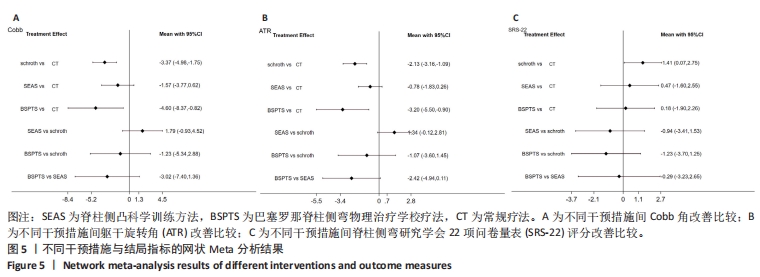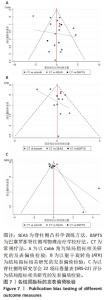Chinese Journal of Tissue Engineering Research ›› 2024, Vol. 28 ›› Issue (36): 5899-5904.doi: 10.12307/2024.692
Effectiveness of different specific exercise therapies in treatment of adolescent idiopathic scoliosis: a network meta-analysis
Chang Ying1, Xia Yuan2, Sun Yundi1, Cheng Lulu1, 3, Xiong Wenjuan1, Zhao Xianghu1, 4
- 1School of Sports Medicine, Wuhan Sports University, Wuhan 430079, Hubei Province, China; 2Affiliated Hospital of Hubei Provincial Government, Wuhan 430000, Hubei Province, China; 3Anhui University of Chinese Medicine, Hefei 230012, Anhui Province, China; 4Zhongda Hospital, Southeast University, Nanjing 210009, Jiangsu Province, China
-
Received:2023-09-18Accepted:2023-10-26Online:2024-12-28Published:2024-02-28 -
Contact:Zhao Xianghu, PhD, Therapist in charge, School of Sports Medicine, Wuhan Sports University, Wuhan 430079, Hubei Province, China; Zhongda Hospital, Southeast University, Nanjing 210009, Jiangsu Province, China -
About author:Chang Ying, Master candidate, School of Sports Medicine, Wuhan Sports University, Wuhan 430079, Hubei Province, China -
Supported by:Key University Natural Science Research Project of Anhui Province, No. 2023AH050725 (to CLL)
CLC Number:
Cite this article
Chang Ying, Xia Yuan, Sun Yundi, Cheng Lulu, Xiong Wenjuan, Zhao Xianghu. Effectiveness of different specific exercise therapies in treatment of adolescent idiopathic scoliosis: a network meta-analysis[J]. Chinese Journal of Tissue Engineering Research, 2024, 28(36): 5899-5904.
share this article
Add to citation manager EndNote|Reference Manager|ProCite|BibTeX|RefWorks
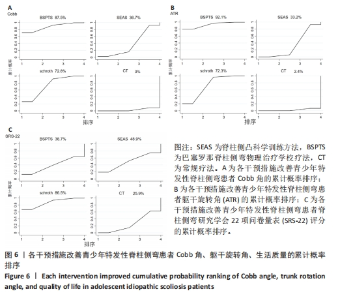
与对照组相比,BSPTS疗法在改善Cobb角方面效果更优[WMD=-4.60,95%CI(-8.37,-0.82),P < 0.05];此外,Schroth运动疗法组在改善Cobb角方面效果也优于对照组[WMD=-3.37,95%CI(-4.98,-1.75),P < 0.05];不同特定疗法组之间在改善Cobb角方面比较差异无显著性意义(P > 0.05),这表明BSPTS疗法与Schroth疗法在改善Cobb角方面要优于对照组,对于Cobb角的改善效果更好。 与对照组相比,BSPTS疗法组在改善躯干旋转角方面效果更优[WMD=-3.20,95%CI(-5.50,-0.90),P < 0.05];此外,Schroth运动疗法组在改善躯干旋转角方面也均优于对照组[WMD=-2.13,5%CI(-3.16,-1.09),P < 0.05]。不同特定疗法组之间在改善躯干旋转角方面比较差异均无显著性意义(P > 0.05),这表明BSPTS疗法与Schroth疗法在改善躯干旋转角方面要优于对照组,对于躯干旋转角的改善效果更好。 与对照组相比,Schroth疗法在改善SRS-22评分方面效果更优[WMD=1.41,95%CI(0.07,2.75),P < 0.05];其他特定疗法组SRS-22评分两两比较差异均无显著性意义(P > 0.05)。 2.3.3 结局指标累计概率排序结果 在Cobb角、躯干旋转角、SRS-22的累计概率排序中,累计曲线下面积值越高,表明使用该种干预方案对治疗青少年特发性脊柱侧弯的有效性越好。结果显示,在结局指标Cobb角和躯干旋转角中均为BSPTS疗法有效性最高,分别是87.5%,92.1%,提示BSPTS疗法可能是改善青少年特发性脊柱侧弯患者Cobb角、躯干旋转角最好的治疗方式。在生活质量方面,Schroth疗法组的SRS-22评分较高,为86.5%,提示Schroth疗法在改善生活质量方面最优。各结局指标累计概率排图如图6所示。"
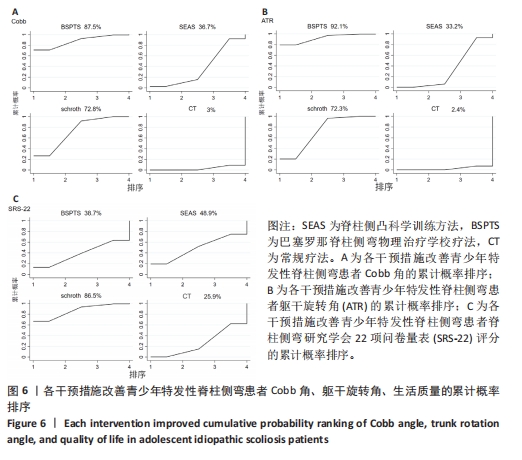
| [1] NEGRINI S, DONZELLI S, AULISA AG, et al. 2016 SOSORT guidelines: orthopaedic and rehabilitation treatment of idiopathic scoliosis during growth. Scoliosis Spinal Disord. 2018;13(1):1-48. [2] QIU GX. Scoliosis in China: history and present status. Chin Med J (Engl). 2017;130(21):2521-2523. [3] SOSORT GUIDELINE COMMITTEE; WEISS HR, NEGRINI S, et al. Indications for conservative management of scoliosis (guidelines). Scoliosis. 2006;1:1-5. [4] PENG Y, WANG SR, QIU GX, et al. Research progress on the etiology and pathogenesis of adolescent idiopathic scoliosis. Chin Med J (Engl). 2020;133(4):483-493. [5] NEGRINI S, HRESKO TM, O’BRIEN JP, et al. Recommendations for research studies on treatment of idiopathic scoliosis: Consensus 2014 between SOSORT and SRS non–operative management committee. Scoliosis. 2015;10:1-12. [6] SELEVICIENE V, CESNAVICIUTE A, STRUKCINSKIENE B, et al. Physiotherapeutic scoliosis-specific exercise methodologies used for conservative treatment of adolescent idiopathic scoliosis, and their effectiveness: An extended literature review of current research and practice. Int J Environ Res Public Health. 2022;19(15):9240. [7] DAY JM, FLETCHER J, COGHLAN M, et al. Review of scoliosis-specific exercise methods used to correct adolescent idiopathic scoliosis. Arch Physiother. 2019;9:1-11. [8] PŁASZEWSKI M, BETTANY-SALTIKOV J. Non-surgical interventions for adolescents with idiopathic scoliosis: an overview of systematic reviews. PloS One. 2014;9(10):e110254. [9] 叶勇智.轻度特发性脊柱侧凸患者应用脊柱侧凸特定运动疗法的可行性[J].中外医学研究, 2018,16(28):19-21. [10] 张亚杰,王连成,董佳兴,等.不同保守方式治疗青少年特发性脊柱侧凸的疗效对比[J].实用骨科杂志,2022,28(1):8-11,19. [11] 靳梦蝶,周璇,李欣,等.特定运动疗法对特发性脊柱侧弯的效果[J].中国康复理论与实践, 2022,28(7):841-847. [12] 妙定坤,张潜龙.以脊柱侧凸特定运动疗法为核心的康复干预在轻度特发性脊柱侧凸中的应用[J].实用临床医药杂志,2018,22(23):160-162. [13] AKYUREK E, ZENGIN ALPOZGEN A, AKGUL T. The preliminary results of physiotherapy scoliosis-specific exercises on spine joint position sense in adolescent idiopathic scoliosis: A randomized controlled trial. Prosthet Orthot Int. 2022;46(5): 510-517. [14] MOHAMED RA, YOUSEF AM. Impact of Schroth three-dimensional vs. proprioceptive neuromuscular facilitation techniques in adolescent idiopathic scoliosis: a randomized controlled study. Eur Rev Med Pharmacol Sci. 2021;25(24):7717-7725. [15] GAO A, LI JY, SHAO R, et al. Schroth exercises improve health-related quality of life and radiographic parameters in adolescent idiopathic scoliosis patients. Chin Med J (Engl). 2021;134(21): 2589-2596. [16] KOCAMAN H, BEK N, KAYA MH, et al. The effectiveness of two different exercise approaches in adolescent idiopathic scoliosis: A single-blind, randomized-controlled trial. PLoS One. 2021;16(4): e0249492. [17] KURU T, YELDAN İ, DERELI EE, et al. The efficacy of three-dimensional Schroth exercises in adolescent idiopathic scoliosis: a randomised controlled clinical trial. Clin Rehabil. 2016;30(2):181-190. [18] SCHREIBER S, PARENT EC, KHODAYARI MOEZ E, et al. Schroth physiotherapeutic scoliosis-specific exercises added to the standard of care lead to better Cobb angle outcomes in adolescents with idiopathic scoliosis–an assessor and statistician blinded randomized controlled trial. PloS One. 2016;11(12): e0168746. [19] KIM G, HWANGBO PN. Effects of Schroth and Pilates exercises on the Cobb angle and weight distribution of patients with scoliosis. J Phys Ther Sci. 2016;28(3):1012-1015. [20] HWANGBO PN. Psychological and physical effects of Schroth and Pilates exercise on female high school students with idiopathic scoliosis. J Korean Phys Ther. 2016;28(6):364-368. [21] 胡丽杰.脊柱侧凸特定运动—BSPTS疗法对轻度青少年特发性脊柱侧凸的疗效观察[D].天津:天津体育学院,2022. [22] ZAPATA KA, SUCATO DJ, JO CH. Physical Therapy Scoliosis-Specific Exercises May Reduce Curve Progression in Mild Adolescent Idiopathic Scoliosis Curves. Pediatr Phys Ther. 2019;31(3):280-285. [23] ZHENG Y, DANG Y, YANG Y, et al. Whether orthotic management and exercise are equally effective to the patients with adolescent idiopathic scoliosis in mainland China? Spine (Phila Pa 1976). 2018;43(9): E494-E503. [24] NEGRINI S, DONZELLI S, NEGRINI A, et al. Specific exercises reduce the need for bracing in adolescents with idiopathic scoliosis: A practical clinical trial. Ann Phys Rehabil Med. 2019;62(2): 69-76. [25] ZAINA F, NEGRINI S, ATANASIO S, et al. Specific exercises performed in the period of brace weaning can avoid loss of correction in Adolescent Idiopathic Scoliosis (AIS) patients: Winner of SOSORT’s 2008 Award for Best Clinical Paper. Scoliosis. 2009;4:8. [26] MONTICONE M, AMBROSINI E, CAZZANIGA D, et al. Active self-correction and task-oriented exercises reduce spinal deformity and improve quality of life in subjects with mild adolescent idiopathic scoliosis. Results of a randomised controlled trial. Eur Spine J. 2014;23(6):1204-1214. [27] 肖军,邱贵兴,吴志宏.实验性脊柱侧弯的研究进展[J].中华医学杂志,2006,86(19):1361-1364. [28] CHEN Y, ZHANG Z, ZHU Q. The effect of an exercise intervention on adolescent idiopathic scoliosis: a network meta-analysis. J Orthop Surg Res. 2023; 18(1):655. [29] CEBALLOS-LAITA L, CARRASCO-URIBARREN A, CABANILLAS-BAREA S, et al. The effectiveness of Schroth method in Cobb angle, quality of life and trunk rotation angle in adolescent idiopathic scoliosis: a systematic review and meta-analysis. Eur J Phys Rehabil Med. 2023;59(2):228-236. [30] THOMPSON JY, WILLIAMSON EM, WILLIAMS MA, et al. Effectiveness of scoliosis-specific exercises for adolescent idiopathic scoliosis compared with other non-surgical interventions: a systematic review and meta-analysis. Physiotherapy. 2019; 105(2):214-234. [31] MA K, WANG C, HUANG Y, et al. The effects of physiotherapeutic scoliosis-specific exercise on idiopathic scoliosis in children and adolescents: a systematic review and meta-analysis. Physiotherapy. 2023;121:46-57. [32] PARK JH, JEON HS, PARK HW. Effects of the Schroth exercise on idiopathic scoliosis: a meta-analysis. Eur J Phys Rehabil Med. 2017;54(3):440-449. [33] GÁMIZ-BERMÚDEZ F, OBRERO-GAITÁN E, ZAGALAZ-ANULA N, et al. Corrective exercise-based therapy for adolescent idiopathic scoliosis: Systematic review and meta-analysis. Clin Rehabil. 2022;36(5):597-608. [34] BUNNELL WP. An objective criterion for scoliosis screening. J Bone Joint Surg Am. 1984;66(9): 1381-1387. [35] MONTICONE M,AMBROSINI E,ROCCA B, et al. Responsiveness and Minimal Important Changes of the Scoliosis Research Society-22 Patient Questionnaire in Subjects With Mild Adolescent and Moderate Adult Idiopathic Scoliosis Undergoing Multidisciplinary Rehabilitation. Spine (Phila Pa 1976). 2017; 42(11):E672-E679. [36] BERDISHEVSKY H, LEBEL VA, BETTANY-SALTIKOV J, et al. Physiotherapy scoliosis-specific exercises–a comprehensive review of seven major schools. Scoliosis Spinal Disord. 2016;11(1):20. [37] 侯雷.运动疗法对青少年特发性脊柱侧弯干预效果的网状Meta分析[J].湖北体育科技, 2023,42(7):594-600. [38] NEGRINI S, GRIVAS TB, KOTWICKI T, et al. Guidelines on” Standards of management of idiopathic scoliosis with corrective braces in everyday clinics and in clinical research”: SOSORT Consensus 2008. Scoliosis. 2009;4:2. [39] MARTI CL, GLASSMAN SD, KNOTT PT, et al. Scoliosis Research Society members attitudes towards physical therapy and physiotherapeutic scoliosis specific exercises for adolescent idiopathic scoliosis. Scoliosis. 2015;10(1):16. [40] REZA MA, JO WS, PARK SC. Comparative antitumor activity of jelly ear culinary-medicinal mushroom, Auricularia auricula-judae (Bull.) J. Schrot. (higher basidiomycetes) extracts against tumor cells in vitro. Int J Med Mushrooms. 2012; 14(4):403-409. |
| [1] | Zhong Jun, Wang Wen. Network meta-analysis of different anatomical repair strategies to improve chronic lateral ankle instability [J]. Chinese Journal of Tissue Engineering Research, 2024, 28(9): 1470-1476. |
| [2] | Zhang Xiaoyun, Liu Hua, Chai Yuan, Chen Feng, Zeng Hao, Gao Zhengang, Huang Yourong. Effect of Yishen Gushu Formula on bone metabolic markers and clinical efficacyn in patients with osteoporosis of kidney deficiency and blood stasis type [J]. Chinese Journal of Tissue Engineering Research, 2024, 28(8): 1155-1160. |
| [3] | Wu Maodong, Su Qinglun, Huang Yiming, Shen Longying, Lu Yu, Zhao Qin. Correlation between coronal pressure variation and coronal imbalance in adolescent idiopathic scoliosis patients [J]. Chinese Journal of Tissue Engineering Research, 2024, 28(6): 852-856. |
| [4] | Hu Zhixing, Li Qun, Yang Chao, Wang Xiaoxiao, Fang Luochangting, Hou Wuqiong, Lin Na, Chen Weiheng, Liu Chunfang, Lin Ya. Network meta-analysis of the modeling effects of different factors on rabbit models of steroid-induced osteonecrosis of femoral head [J]. Chinese Journal of Tissue Engineering Research, 2024, 28(6): 976-984. |
| [5] | Zhu Xiaofeng, Chen Weiwei, Huang Jian. Effects of maternal high-fat diet and exercise intervention on insulin sensitivity and the hypothalamic arcuate nucleus in male offspring mice [J]. Chinese Journal of Tissue Engineering Research, 2024, 28(4): 556-561. |
| [6] | Hou Yutong, Huang Chenglan, Yang Yunxiao, Li Ya, Guo Peiwu, Yu Wenqiang, Zhao Yu, Wang Zanbo, Zeng Hong, Ma Zhenjiang, Lu Dezhi, Wang Jinwu. Correlation between lumbar spine and pelvic parameters in Lenke type 5 adolescent idiopathic scoliosis [J]. Chinese Journal of Tissue Engineering Research, 2024, 28(36): 5753-5758. |
| [7] | Zhang Jinpu, Wang Junli, Zhang Siqi, Chen Jiahao, Yang Qiushi. Effectiveness of exercise interventions for fibromyalgia syndrome: a Meta-analysis [J]. Chinese Journal of Tissue Engineering Research, 2024, 28(32): 5210-5216. |
| [8] | Jia Hongsheng, Wang Fan, Chen Chun, Sun Bo, Fang Shengqi. Network meta-analysis on efficacy and safety of different biological agents in treatment of rheumatoid arthritis [J]. Chinese Journal of Tissue Engineering Research, 2024, 28(29): 4748-4756. |
| [9] | Hou Zhaomeng, Su Shaoting, Chen Longhao, Wei Guikang, Zhou Honghai. Visualization analysis of research hotspots and trends in adolescent idiopathic scoliosis [J]. Chinese Journal of Tissue Engineering Research, 2024, 28(21): 3424-3430. |
| [10] | Chang Wanpeng, Zhang Zhongwen, Yang Yulin, Zi Yang, Yang Mengqi, Du Bingyu, Wang Nan, Yu Shaohong. Efficacy of rehabilitation exoskeleton robots on post-stroke lower limb motor dysfunction: a Meta-analysis [J]. Chinese Journal of Tissue Engineering Research, 2024, 28(2): 321-328. |
| [11] | Yang Yulin, Chang Wanpeng, Ding Jiangtao, Xu Hongli, Wu Xiao, Xiao Boheng, Ma Lihong. Transcranial direct current stimulation at different targets for Parkinson’s disease: a network Meta-analysis [J]. Chinese Journal of Tissue Engineering Research, 2024, 28(11): 1797-1804. |
| [12] | Jiang Xiaocheng, Shi Lu, Wang Yinbin, Li Qiujiang, Xi Chuangzhen, Ma Zefeng, Cai Lijun. Systematical evaluation of bone fusion rate after interbody fusion in patients with osteoporosis and lumbar degenerative disease treated with teriparatide [J]. Chinese Journal of Tissue Engineering Research, 2023, 27(9): 1427-1433. |
| [13] | Li Wenjie, You Aijia, Zhou Junli, Fang Sujuan, Li Chun. Effects of different dressings in the treatment of burn wounds: a network meta-analysis [J]. Chinese Journal of Tissue Engineering Research, 2023, 27(7): 1141-1148. |
| [14] | Xin Xiaoming, Gao Mingxuan, Zhang Fan, Chi Fei, Feng Junchao, Luo Wenyuan. Application of orthopedic robot-assisted screw placement in the correction of adolescent idiopathic scoliosis [J]. Chinese Journal of Tissue Engineering Research, 2023, 27(36): 5790-5794. |
| [15] | Chen Peng, Wang Ling, Dong Shiyu, Ding Yue, Jia Shaohui, Kou Xianjuan, Zheng Cheng. Effects of whole-body vibration training on anterior cruciate ligament reconstruction: a meta-analysis [J]. Chinese Journal of Tissue Engineering Research, 2023, 27(36): 5875-5883. |
| Viewed | ||||||
|
Full text |
|
|||||
|
Abstract |
|
|||||
